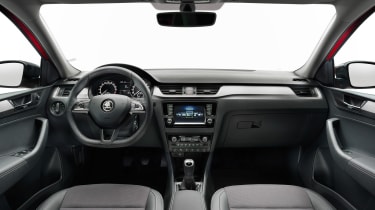Skoda Rapid Spaceback hatchback (2013-2019) - Interior & comfort
The Skoda Rapid Spaceback is spacious and comfortable, particularly on the motorway
When the Rapid Spaceback was introduced, it sought to remedy complaints about the firm suspension of the Rapid hatchback, which struggled with loose drain covers and larger potholes sending shocks into the cabin. The Spaceback is smoother, but you can still distinctly feel road imperfections. It’s a shame given how quiet the cabin is otherwise, especially when the hushed 1.0-litre petrol engine is fitted.
Thankfully, as before, the ride improves once the car has reached motorway speed, and little road or wind noise is audible inside. Diesel rumble aside, the Spaceback actually acquits itself pretty well as a motorway cruiser. Plus, there’s no denying that the extra room in the back is very much appreciated – front and rear-seat occupants can stretch out in comfort.
Skoda Rapid Spaceback dashboard
The dashboard of the Spaceback is carried over from the regular Rapid, and it does as good a job as it always has. While it holds no design surprises, it succeeds in looking classy and neat, and is arranged tidily, making it easy to use. Those with previous experience of VW Group cars will find certain components very familiar, and those parts help to boost the sense of quality.
Not all of the dashboard meets the same standard, though, with some materials used feeling less pleasant to touch than would be ideal. It’s a shame, but inevitable that Skoda had to reduce material costs to meet the lower price point of the Rapid compared to the Golf. A 2017 facelift included an updated instrument cluster and introduced USB ports for rear-seat passengers.
Equipment
The headline news is that the entry-level Spaceback S costs significantly less than its hatchback equivalent. Better still, even this version comes with air-conditioning as standard, whereas you have to move up to the SE to get that in the hatchback. Other standard kit includes remote central locking, electric front windows, a height-adjustable driver’s seat and a steering wheel that can be raised, lowered and moved in and out.
More reviews
The SE Tech model has a notably higher specification, with a touchscreen sat-nav system and Bluetooth phone link, rear parking sensors, dual-zone climate-control air-conditioning and cruise control. There are also a set of 16-inch alloy wheels and tinted glass to add style outside. SE Tech also opens the engine choices to include the larger and more powerful petrols and diesels.
If you want to make the most of the Spaceback’s attractive shape, the SE Sport adds to the SE Tech’s kit with a panoramic glass sunroof, dark tinted glass, tinted lights, sports seats and attractive piano-black surfaces inside. The 17-inch alloy wheels look the part, too – although it’s worth taking a test drive to check you get on with the ride quality. We found that the bigger wheels further exacerbate the Rapid’s difficulty in dealing with potholes.
Options
The Rapid Spaceback SE Tech is already a very well equipped car indeed, but there are still a number of options available that might tempt you. We’d recommend the extra winter comfort and convenience of heated front seats and screen washer nozzles for £205, as well as the handy speed-limiter function for the cruise control, at £50.
The driver fatigue assistant is an invaluable safety asset, and for £50 it almost orders itself. Furthermore, we’d be strongly tempted by the Front Assistant system, which uses radar to detect obstacles in your path and applies the brakes if necessary. The worth of this system has been amply demonstrated (your insurer may give you a discount for it) so we consider it £315 well spent.
The infotainment system has been given a welcome update for 2017, enabling new features like Skoda Connect (with a subscription), which can provide real-time traffic information, and CareConnect, a service that can automatically alert the emergency services of a collision, let you request help at the roadside and even book a service.
Owners can connect to the car using a smartphone app to check its status (including fuel level, whether it’s locked and if the windows are shut) and send destinations to the sat nav. We’d also recommend ticking the box for SmartLink, which enables Apple CarPlay, Android Auto and MirrorLink functionality, although it’s a shame Skoda charges £150 for this when quite a few rivals include it for free.












